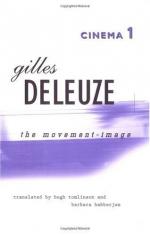
|
| Name: _________________________ | Period: ___________________ |
This test consists of 15 multiple choice questions and 5 short answer questions.
Multiple Choice Questions
1. What word does Pierce associate with "Thirdness"?
(a) Affection.
(b) Mental.
(c) Voyage.
(d) Action.
2. Deleuze believes that Bunuel's work is characterized by which quality?
(a) Impulsiveness.
(b) Expressionism.
(c) Repetition.
(d) Organic trends.
3. What kind of director does Deleuze believe to have the most difficulty with naturalism?
(a) American.
(b) Soviet.
(c) Pre-war French.
(d) German.
4. What is the first of five traits of the new image, as designated by Deleuze?
(a) Firstness.
(b) Thirdness.
(c) ASA.
(d) Dispersive.
5. Deleuze claims that impression links situation with which other element?
(a) Action.
(b) Reaction.
(c) Perception.
(d) Impulse.
6. What is the name of the form in which things move from situation to action?
(a) SAS.
(b) SAA.
(c) ASA.
(d) AAS.
7. The formula ASA brings out the distance between which of the following?
(a) Images.
(b) Indexes.
(c) Actions.
(d) Situations.
8. The example of emotion as an object using the glove appears in which film?
(a) Titanic.
(b) Gone with the Wind.
(c) On the Waterfront.
(d) Casablanca.
9. What is the second pole of action-image?
(a) Binomial.
(b) Behavior.
(c) Genetics.
(d) Firstness.
10. Who does Deleuze describe as obsessed with naturalism but unable to use it?
(a) Stroheim.
(b) Bunuel.
(c) Griffith.
(d) Fuller.
11. What was Herzog's second obsessive theme?
(a) Heroic action.
(b) Aesthetics.
(c) Hallucinatory elements.
(d) Landscape.
12. What is the second of five traits of the new image, as designated by Deleuze?
(a) Very strong links.
(b) Cliche condemnation.
(c) Deliberate weak links.
(d) Superiority.
13. What is the name of the form in which things move from action to situation.
(a) AAS.
(b) SAS.
(c) ASA.
(d) SAA.
14. Who directed "Heaven and Hell"?
(a) Dostoevsky.
(b) Mizoguchi.
(c) Eisenstein.
(d) Kurosawa.
15. Who is the first man Deleuze calls a cinematic master of realism?
(a) Stroheim.
(b) Epstein.
(c) Griffith.
(d) Eisenstein.
Short Answer Questions
1. According to Deleuze, what was Fuller unable to break?
2. A slight difference in gesture creates a huge difference in laughter, which is referred to with which term?
3. What kind of film does Deleuze say frees any-space-whatevers from human coordinates?
4. A complex entity can be which of the following?
5. Whose film was "Our Hospitality"?
|
This section contains 337 words (approx. 2 pages at 300 words per page) |

|




